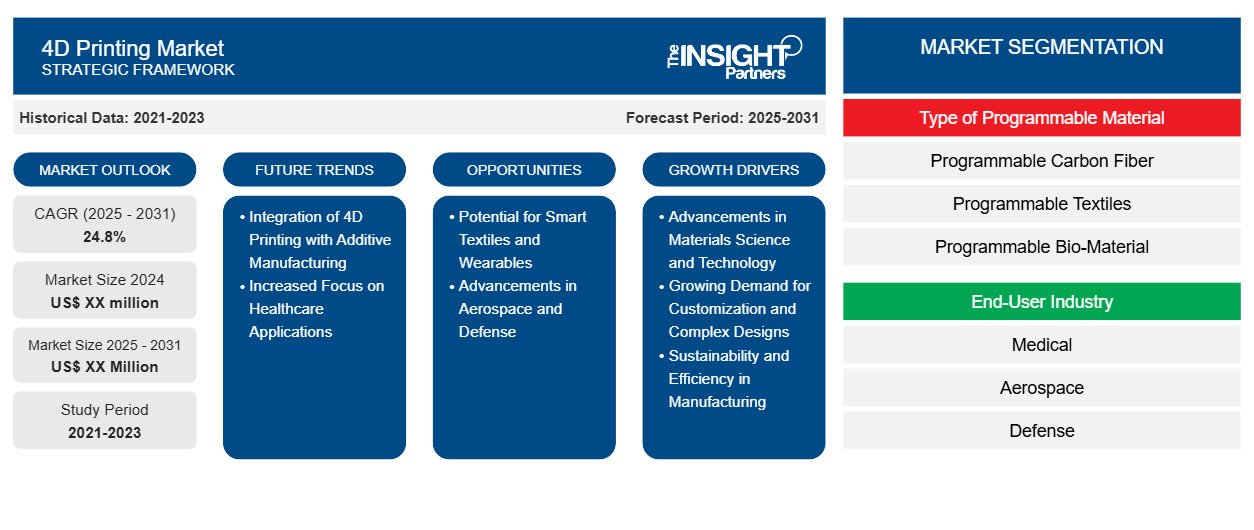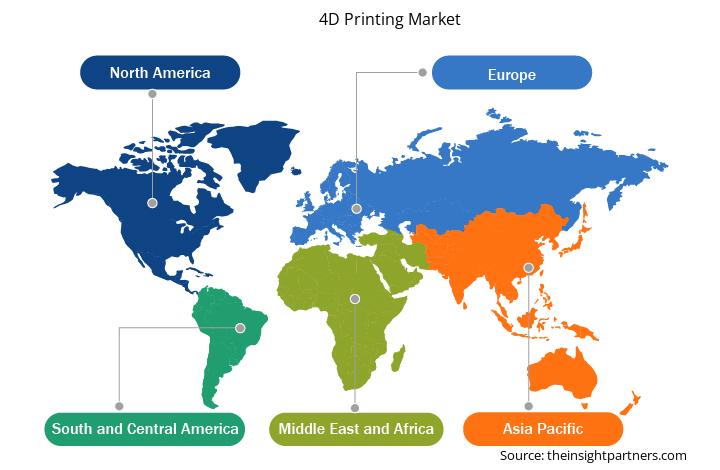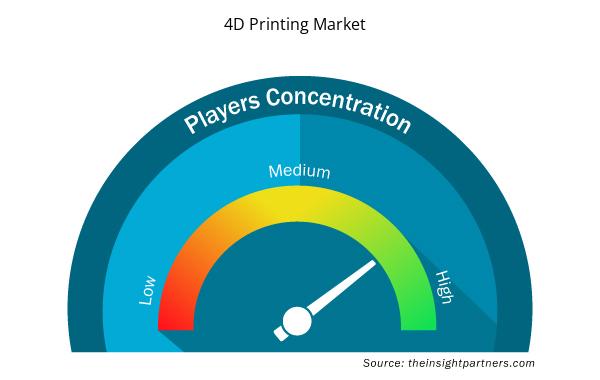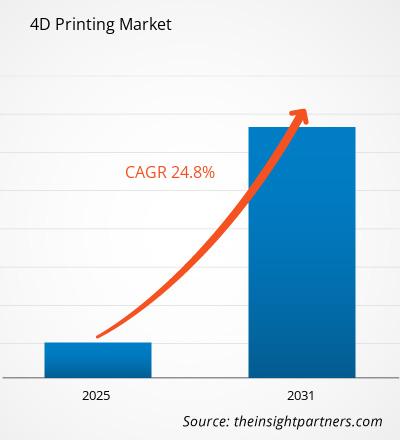من المتوقع أن يسجل سوق الطباعة رباعية الأبعاد معدل نمو سنوي مركب بنسبة 24.8٪ من عام 2025 إلى عام 2031، مع توسع حجم السوق من XX مليون دولار أمريكي في عام 2024 إلى XX مليون دولار أمريكي بحلول عام 2031.
يُقسّم التقرير حسب نوع المواد القابلة للبرمجة (ألياف الكربون القابلة للبرمجة، المنسوجات القابلة للبرمجة، المواد الحيوية القابلة للبرمجة، الخشب القابل للبرمجة)، وقطاعات المستخدم النهائي (الطب، والفضاء، والدفاع، والسيارات، وغيرها). ويُفصّل التحليل العالمي على المستوى الإقليمي والدول الرئيسية. ويُقدّم التقرير القيمة بالدولار الأمريكي للتحليل والقطاعات المذكورة أعلاه.
غرض التقرير
يهدف تقرير "سوق الطباعة رباعية الأبعاد" الصادر عن شركة "إنسايت بارتنرز" إلى وصف المشهد الحالي والنمو المستقبلي، وأهم العوامل المحفزة، والتحديات، والفرص المتاحة. وسيوفر هذا التقرير رؤى ثاقبة لمختلف أصحاب المصلحة في قطاع الأعمال، مثل:
- مزودي التكنولوجيا/المصنعين: لفهم ديناميكيات السوق المتطورة ومعرفة فرص النمو المحتملة، وتمكينهم من اتخاذ قرارات استراتيجية مستنيرة.
- المستثمرون: إجراء تحليل شامل للاتجاهات فيما يتعلق بمعدل نمو السوق، والتوقعات المالية للسوق، والفرص المتاحة عبر سلسلة القيمة.
- الهيئات التنظيمية: لتنظيم السياسات ومراقبة الأنشطة في السوق بهدف تقليل الانتهاكات والحفاظ على ثقة المستثمرين ودعم سلامة السوق واستقرارها.
تجزئة سوق الطباعة رباعية الأبعاد
نوع المادة القابلة للبرمجة
- ألياف الكربون القابلة للبرمجة
- المنسوجات القابلة للبرمجة
- المواد الحيوية القابلة للبرمجة
- الخشب القابل للبرمجة
صناعة المستخدم النهائي
- طبي
- الفضاء الجوي
- الدفاع
- السيارات
قم بتخصيص هذا التقرير ليناسب متطلباتك
ستحصل على تخصيص لأي تقرير - مجانًا - بما في ذلك أجزاء من هذا التقرير، أو تحليل على مستوى الدولة، وحزمة بيانات Excel، بالإضافة إلى الاستفادة من العروض والخصومات الرائعة للشركات الناشئة والجامعات
سوق الطباعة رباعية الأبعاد: رؤى استراتيجية

- احصل على أهم اتجاهات السوق الرئيسية لهذا التقرير.ستتضمن هذه العينة المجانية تحليل البيانات، بدءًا من اتجاهات السوق وحتى التقديرات والتوقعات.
عوامل نمو سوق الطباعة رباعية الأبعاد
- التطورات في علوم وتكنولوجيا المواد: يُعدّ التقدم السريع في علوم المواد أحد العوامل الرئيسية الدافعة لسوق الطباعة رباعية الأبعاد. يُسهم تطوير مواد ذكية قادرة على تغيير شكلها أو خصائصها استجابةً للمؤثرات البيئية، مثل درجة الحرارة والرطوبة والضوء، في نموّ الطباعة رباعية الأبعاد. تُتيح هذه المواد، بما في ذلك البوليمرات المتذكرة للشكل، والهيدروجيل، والمواد ذاتية الشفاء، إنشاء أجسام ديناميكية قادرة على التكيف مع الظروف المتغيرة، مما يفتح آفاقًا جديدة في مختلف الصناعات.hydrogels, and self-healing materials, allow for the creation of dynamic objects that can adapt to changing conditions, which opens up new possibilities across various industries.
- الطلب المتزايد على التخصيص والتصميمات المعقدة: مع سعي قطاعات مثل الرعاية الصحية والفضاء والسيارات إلى حلول أكثر تعقيدًا وتخصيصًا وتكيفًا، تُقدم الطباعة رباعية الأبعاد ميزةً تتمثل في تمكينها من إنشاء أجسام قابلة للتطور بمرور الوقت أو استجابةً لمحفزات محددة. هذا الطلب المتزايد على المنتجات المصممة خصيصًا وعالية الأداء يُعزز الحاجة إلى تقنيات الطباعة رباعية الأبعاد، إذ تُتيح فرصًا فريدة لإنشاء هياكل لا تستطيع طرق التصنيع التقليدية تحقيقها.
- الاستدامة والكفاءة في التصنيع: من المتوقع أن تُسهم الطباعة رباعية الأبعاد في عمليات تصنيع أكثر استدامة وكفاءة. فعلى عكس التصنيع التقليدي، حيث تُهدر المواد غالبًا، تُتيح الطباعة رباعية الأبعاد إنتاج منتجات قابلة للتكيف، قادرة على تغيير شكلها ووظائفها دون الحاجة إلى مواد إضافية. ويُمكن لهذه القدرة على التكيف أن تُقلل من الأثر البيئي للتصنيع، وأن تجعل سلاسل التوريد أكثر كفاءة، مما يُناسب الصناعات التي تُركز على الاستدامة وتقليل النفايات.
اتجاهات مستقبل سوق الطباعة رباعية الأبعاد
- دمج الطباعة رباعية الأبعاد مع التصنيع الإضافي: يُعد دمج الطباعة رباعية الأبعاد مع تقنيات التصنيع الإضافي (الطباعة ثلاثية الأبعاد) الحالية اتجاهًا ناشئًا. فبينما تُركز الطباعة ثلاثية الأبعاد على إنشاء أجسام ثابتة، تُضفي الطباعة رباعية الأبعاد بُعدًا جديدًا للتغيير مع مرور الوقت، مما يُتيح إنشاء أجسام قادرة على التجميع الذاتي، وإعادة التكوين، أو تغيير خصائصها استجابةً للمحفزات. يُسهم هذا التكامل في تطوير تطبيقات جديدة في قطاعات مثل الفضاء والسيارات والرعاية الصحية، حيث تُعدّ المواد الديناميكية سريعة الاستجابة ذات قيمة عالية.
- زيادة التركيز على تطبيقات الرعاية الصحية: يتزايد التوجه نحو استخدام الطباعة رباعية الأبعاد في قطاع الرعاية الصحية. ومع ظهور الطباعة رباعية الأبعاد، أصبحت تطبيقات مثل الهندسة الحيوية، وتوصيل الأدوية، والأطراف الصناعية، والغرسات أكثر تطورًا. على سبيل المثال، يمكن للأجهزة الطبية المطبوعة بتقنية الطباعة رباعية الأبعاد تغيير شكلها أو صلابتها استجابةً لدرجة حرارة الجسم أو عوامل بيئية أخرى، مما يُحسّن نتائج المرضى. وفي ظل سعي مؤسسات الرعاية الصحية إلى إيجاد طرق مبتكرة لمواجهة التحديات الطبية المعقدة، فإن الطباعة رباعية الأبعاد على أهبة الاستعداد لإحداث نقلة نوعية في الطب الشخصي ورعاية المرضى.
فرص سوق الطباعة رباعية الأبعاد
- إمكانات المنسوجات الذكية والأجهزة القابلة للارتداء: يُتيح سوق الطباعة رباعية الأبعاد فرصًا واعدة في تطوير المنسوجات الذكية وتقنياتها القابلة للارتداء. تُتيح الطباعة رباعية الأبعاد إنتاج أقمشة ومواد قابلة لتغيير شكلها، والتكيف مع الظروف البيئية، أو تلبية احتياجات المستخدم، مما يجعلها مثالية للملابس الذكية، والأجهزة القابلة للارتداء عالية الأداء، والأجهزة الطبية المتكيّفة. تمتد هذه الفرصة لتشمل العديد من القطاعات، بما في ذلك الأزياء، والرعاية الصحية، والرياضة، حيث تحظى المواد المتكيّفة والمستجيبة بإقبال كبير.Wearables: The 4D printing market presents opportunities in the development of smart textiles and wearable technology. 4D printing allows for the creation of fabrics and materials that can change shape, adapt to environmental conditions, or adjust to user needs, making them ideal for smart clothing, performance wearables, and adaptive medical devices. This opportunity extends across several industries, including fashion, healthcare, and sports, where adaptive and responsive materials are highly sought after.
- التطورات في مجالي الطيران والدفاع: يستكشف قطاعا الطيران والدفاع تقنيات الطباعة رباعية الأبعاد لإنتاج مكونات أكثر كفاءةً وخفةً في الوزن ومرونة. على سبيل المثال، يمكن استخدام المكونات المطبوعة رباعية الأبعاد في الطائرات أو المركبات الفضائية التي يتغير شكلها استجابةً لتغيرات الضغط أو درجة الحرارة، مما يُحسّن أدائها. تُتيح إمكانية خفض التكاليف، وتحسين كفاءة استهلاك الوقود، وزيادة عمر المواد، فرصًا كبيرة للشركات العاملة في هذه القطاعات لتبني حلول الطباعة رباعية الأبعاد.
رؤى إقليمية حول سوق الطباعة رباعية الأبعاد
قام محللو شركة إنسايت بارتنرز بشرح شامل للاتجاهات الإقليمية والعوامل المؤثرة في سوق الطباعة رباعية الأبعاد خلال فترة التوقعات. ويناقش هذا القسم أيضًا قطاعات سوق الطباعة رباعية الأبعاد ونطاقها الجغرافي في أمريكا الشمالية، وأوروبا، وآسيا والمحيط الهادئ، والشرق الأوسط وأفريقيا، وأمريكا الجنوبية والوسطى.

- احصل على البيانات الإقليمية المحددة لسوق الطباعة رباعية الأبعاد
نطاق تقرير سوق الطباعة رباعية الأبعاد
| سمة التقرير | تفاصيل |
|---|---|
| حجم السوق في عام 2024 | XX مليون دولار أمريكي |
| حجم السوق بحلول عام 2031 | XX مليون دولار أمريكي |
| معدل النمو السنوي المركب العالمي (2025 - 2031) | 24.8% |
| البيانات التاريخية | 2021-2023 |
| فترة التنبؤ | 2025-2031 |
| القطاعات المغطاة | حسب نوع المادة القابلة للبرمجة
|
| المناطق والدول المغطاة | أمريكا الشمالية
|
| قادة السوق وملفات تعريف الشركات الرئيسية |
|
كثافة اللاعبين في سوق الطباعة رباعية الأبعاد: فهم تأثيرها على ديناميكيات الأعمال
يشهد سوق الطباعة رباعية الأبعاد نموًا سريعًا، مدفوعًا بتزايد طلب المستخدم النهائي نتيجةً لعوامل مثل تطور تفضيلات المستهلكين، والتقدم التكنولوجي، وزيادة الوعي بمزايا المنتج. ومع تزايد الطلب، تعمل الشركات على توسيع عروضها، والابتكار لتلبية احتياجات المستهلكين، والاستفادة من الاتجاهات الناشئة، مما يعزز نمو السوق.
تشير كثافة اللاعبين في السوق إلى توزيع الشركات العاملة في سوق أو قطاع معين. وتشير إلى عدد المنافسين (اللاعبين في السوق) الموجودين في سوق معين نسبةً إلى حجمه أو قيمته السوقية الإجمالية.
الشركات الرئيسية العاملة في سوق الطباعة رباعية الأبعاد هي:
- شركة أورجانوفو القابضة
- بيكو
- شركة ستراتاسيس المحدودة
- ماتريالايز إن في
- شركة أوتوديسك
إخلاء المسؤولية : الشركات المذكورة أعلاه ليست مرتبة بأي ترتيب معين.

- احصل على نظرة عامة على أهم اللاعبين الرئيسيين في سوق الطباعة رباعية الأبعاد
نقاط البيع الرئيسية
- التغطية الشاملة: يغطي التقرير بشكل شامل تحليل المنتجات والخدمات والأنواع والمستخدمين النهائيين لسوق الطباعة ثلاثية الأبعاد، مما يوفر مشهدًا شاملاً.
- تحليل الخبراء: تم تجميع التقرير على أساس الفهم العميق لخبراء الصناعة والمحللين.
- معلومات محدثة: يضمن التقرير أهمية الأعمال التجارية بسبب تغطيته للمعلومات الحديثة واتجاهات البيانات.
- خيارات التخصيص: يمكن تخصيص هذا التقرير لتلبية متطلبات العملاء المحددة وتلبية استراتيجيات العمل بشكل مناسب.
لذا، يُمكن أن يُساعد تقرير البحث حول سوق الطباعة رباعية الأبعاد في تمهيد الطريق لفهم سيناريو هذه الصناعة وآفاق نموها. ورغم وجود بعض المخاوف المُبررة، إلا أن فوائد هذا التقرير الإجمالية تفوق عيوبه.
- التحليل التاريخي (سنتان)، السنة الأساسية، التوقعات (7 سنوات) مع معدل النمو السنوي المركب
- تحليل PEST و SWOT
- حجم السوق والقيمة / الحجم - عالميًا وإقليميًا وقطريًا
- الصناعة والمنافسة
- مجموعة بيانات Excel



Report Coverage
Revenue forecast, Company Analysis, Industry landscape, Growth factors, and Trends

Segment Covered
This text is related
to segments covered.

Regional Scope
North America, Europe, Asia Pacific, Middle East & Africa, South & Central America

Country Scope
This text is related
to country scope.
الأسئلة الشائعة
Integration of 4D Printing with Additive Manufacturing is likely to remain a key trend in the market.
Key players in the 4D printing market include Organovo Holdings Inc., BICO, Stratasys Ltd., Materialise NV, Autodesk Inc., Hewlett Packard Enterprise Company, CT Core Technology Group, EnvisionTEC Inc., ExOne Corporation, and Norsk Titanium US Inc.
Some of the customization options available based on the request are an additional 3–5 company profiles and country-specific analysis of 3–5 countries of your choice. Customizations are to be requested/discussed before making final order confirmation# as our team would review the same and check the feasibility
The major factors driving the 4D printing market are:
1. Advancements in Materials Science and Technology.
2.Growing Demand for Customization and Complex Designs
The 4D printing market is estimated to witness a CAGR of 24.8% from 2024 to 2031
Trends and growth analysis reports related to Electronics and Semiconductor : READ MORE..
The Insight Partners performs research in 4 major stages: Data Collection & Secondary Research, Primary Research, Data Analysis and Data Triangulation & Final Review.
- Data Collection and Secondary Research:
As a market research and consulting firm operating from a decade, we have published and advised several client across the globe. First step for any study will start with an assessment of currently available data and insights from existing reports. Further, historical and current market information is collected from Investor Presentations, Annual Reports, SEC Filings, etc., and other information related to company’s performance and market positioning are gathered from Paid Databases (Factiva, Hoovers, and Reuters) and various other publications available in public domain.
Several associations trade associates, technical forums, institutes, societies and organization are accessed to gain technical as well as market related insights through their publications such as research papers, blogs and press releases related to the studies are referred to get cues about the market. Further, white papers, journals, magazines, and other news articles published in last 3 years are scrutinized and analyzed to understand the current market trends.
- Primary Research:
The primarily interview analysis comprise of data obtained from industry participants interview and answers to survey questions gathered by in-house primary team.
For primary research, interviews are conducted with industry experts/CEOs/Marketing Managers/VPs/Subject Matter Experts from both demand and supply side to get a 360-degree view of the market. The primary team conducts several interviews based on the complexity of the markets to understand the various market trends and dynamics which makes research more credible and precise.
A typical research interview fulfils the following functions:
- Provides first-hand information on the market size, market trends, growth trends, competitive landscape, and outlook
- Validates and strengthens in-house secondary research findings
- Develops the analysis team’s expertise and market understanding
Primary research involves email interactions and telephone interviews for each market, category, segment, and sub-segment across geographies. The participants who typically take part in such a process include, but are not limited to:
- Industry participants: VPs, business development managers, market intelligence managers and national sales managers
- Outside experts: Valuation experts, research analysts and key opinion leaders specializing in the electronics and semiconductor industry.
Below is the breakup of our primary respondents by company, designation, and region:

Once we receive the confirmation from primary research sources or primary respondents, we finalize the base year market estimation and forecast the data as per the macroeconomic and microeconomic factors assessed during data collection.
- Data Analysis:
Once data is validated through both secondary as well as primary respondents, we finalize the market estimations by hypothesis formulation and factor analysis at regional and country level.
- Macro-Economic Factor Analysis:
We analyse macroeconomic indicators such the gross domestic product (GDP), increase in the demand for goods and services across industries, technological advancement, regional economic growth, governmental policies, the influence of COVID-19, PEST analysis, and other aspects. This analysis aids in setting benchmarks for various nations/regions and approximating market splits. Additionally, the general trend of the aforementioned components aid in determining the market's development possibilities.
- Country Level Data:
Various factors that are especially aligned to the country are taken into account to determine the market size for a certain area and country, including the presence of vendors, such as headquarters and offices, the country's GDP, demand patterns, and industry growth. To comprehend the market dynamics for the nation, a number of growth variables, inhibitors, application areas, and current market trends are researched. The aforementioned elements aid in determining the country's overall market's growth potential.
- Company Profile:
The “Table of Contents” is formulated by listing and analyzing more than 25 - 30 companies operating in the market ecosystem across geographies. However, we profile only 10 companies as a standard practice in our syndicate reports. These 10 companies comprise leading, emerging, and regional players. Nonetheless, our analysis is not restricted to the 10 listed companies, we also analyze other companies present in the market to develop a holistic view and understand the prevailing trends. The “Company Profiles” section in the report covers key facts, business description, products & services, financial information, SWOT analysis, and key developments. The financial information presented is extracted from the annual reports and official documents of the publicly listed companies. Upon collecting the information for the sections of respective companies, we verify them via various primary sources and then compile the data in respective company profiles. The company level information helps us in deriving the base number as well as in forecasting the market size.
- Developing Base Number:
Aggregation of sales statistics (2020-2022) and macro-economic factor, and other secondary and primary research insights are utilized to arrive at base number and related market shares for 2022. The data gaps are identified in this step and relevant market data is analyzed, collected from paid primary interviews or databases. On finalizing the base year market size, forecasts are developed on the basis of macro-economic, industry and market growth factors and company level analysis.
- Data Triangulation and Final Review:
The market findings and base year market size calculations are validated from supply as well as demand side. Demand side validations are based on macro-economic factor analysis and benchmarks for respective regions and countries. In case of supply side validations, revenues of major companies are estimated (in case not available) based on industry benchmark, approximate number of employees, product portfolio, and primary interviews revenues are gathered. Further revenue from target product/service segment is assessed to avoid overshooting of market statistics. In case of heavy deviations between supply and demand side values, all thes steps are repeated to achieve synchronization.
We follow an iterative model, wherein we share our research findings with Subject Matter Experts (SME’s) and Key Opinion Leaders (KOLs) until consensus view of the market is not formulated – this model negates any drastic deviation in the opinions of experts. Only validated and universally acceptable research findings are quoted in our reports.
We have important check points that we use to validate our research findings – which we call – data triangulation, where we validate the information, we generate from secondary sources with primary interviews and then we re-validate with our internal data bases and Subject matter experts. This comprehensive model enables us to deliver high quality, reliable data in shortest possible time.

 احصل على عينة مجانية لهذا التقرير
احصل على عينة مجانية لهذا التقرير